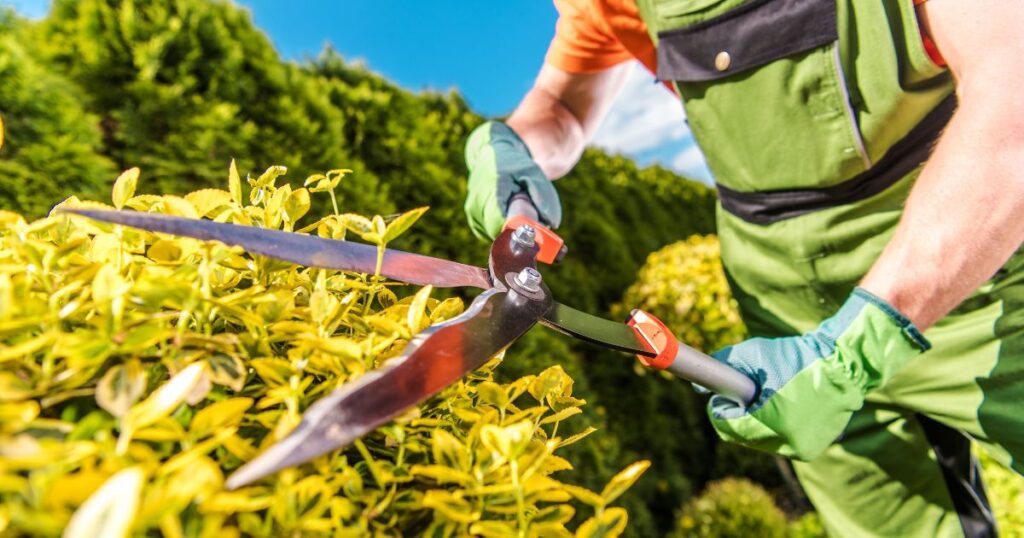
Are you ready to step into a world where green thumbs and creative minds collide? Look no further, aspiring landscape artists, for this guide is your gateway to becoming a bona fide Landscaper Extraordinaire! We’ll unlock the secrets of designing dreamy gardens, sculpting stunning outdoor spaces, and unleashing your inner landscape wizard.
To become a landscaper, gain practical experience by working with established landscaping companies or professionals to learn about different aspects of the job, such as plant care, hardscaping, and landscape design. Consider pursuing formal education or certifications in landscaping or related fields to enhance your knowledge and credentials. Start building a portfolio of your work and skills to showcase your abilities to potential clients or employers.
The Overview of Steps to Become a Landscaper
How to be a landscaper? Becoming a landscaper requires some education, training, experience, and effort on your part. First off, you need to have a high school diploma or GED equivalent before you can undertake any relevant educational program. Enrolling in horticulture or landscape design programs at community colleges or trade schools is also recommended.
On-the-job training is essential for gaining experience in this field. You can start by working for an established landscaping company where you will learn the tools of the trade from seasoned professionals while earning money at the same time.
Once you’ve gained enough knowledge about plants and soil types through formal education and practical experience through on-the-job training, it’s time to start thinking about setting up your own business if that’s what you want to do. The first step towards setting up your own business would entail creating a detailed business plan covering aspects such as defining your target market; creating marketing strategies; financial planning; legal considerations such as business structure options (sole proprietorship, LLC, etc.), licensing requirements, and insurance needs.
RELATED: How to Become Landscaper: Enhancing the Beauty and Functionality of Outdoor Spaces
The Definition of Landscaping
Landscaping is the art and science of modifying or enhancing the visible features of an area of land. This includes anything from selecting and planting trees or shrubs to designing rock formations or water features such as fountains or ponds.
Landscaping can also involve hardscaping elements such as patios, walkways, retaining walls, and other structures that enhance an outdoor space’s functionality. Furthermore, landscaping can incorporate sustainable practices such as composting and rainwater harvesting to conserve water consumption.
Why People Hire Landscapers
The reasons why people hire landscapers vary widely but can typically be divided into two categories: functional and aesthetic. On the functional side, homeowners may want their outdoor space to be more usable by adding a patio for entertaining guests or installing a retaining wall to prevent soil erosion. On the aesthetic side, people may want to beautify their property by adding colorful flower beds or a rock garden that creates a unique ambiance.
What Services Landscapers Offer
Landscapers offer both basic maintenance services like mowing lawns and trimming shrubs plus advanced design services like creating custom gardens or patios. Some landscapers provide additional services such as tree removal or snow removal during winter months.
Becoming a successful landscaper takes education in horticulture or landscape design programs; on-the-job training; learning skills like knowledge about plants and soil types; using landscaping tools and equipment with creativity; developing sustainability practices for business growth. All this effort results in providing high-quality landscape services that bring value to customers while also improving their quality of life through beautiful spaces that become cherished parts of their home environment.
Education and Training
High school diploma or GED
Before pursuing a career as a landscaper, it is essential to obtain a high school diploma or GED. This certification assures employers that you have basic knowledge of reading, writing, and mathematics, which is required for learning about plants and soil types. It will also provide you with an advantage when seeking further education.
Enroll in a horticulture or landscape design program
Enrolling in a horticulture or landscape design program is vital for gaining the necessary education and skills required to become a professional landscaper. These programs offer classes such as botany, soil science, plant identification, landscape design principles, and other related subjects that prepare you for the job.
There are many schools across the United States offering programs like these; some popular examples include California Polytechnic State University in San Luis Obispo and Texas A&M University in College Station. These programs offer certificates and degrees ranging from associate to bachelor’s degrees.
On-the-job training
On-the-job training is highly recommended for every aspiring landscaper. This type of training provides hands-on experience while working alongside professionals already established in the industry. By undergoing on-the-job training, you can understand better customer service skills, how to operate equipment effectively, plant and soil maintenance techniques, and safety protocols, among other valuable lessons.
Many landscaping companies offer apprenticeships where they hire people with little experience to train them on-site while paying them simultaneously. Apprenticeship opportunities are usually available through trade organizations such as the National Association of Landscape Professionals (NALP) or your local community college.
Obtaining formal education, such as enrolling in horticulture or landscape design courses paired with on-the-job training, can help set anyone up on their path toward becoming a professional landscaper. High school diplomas or GEDs are like stepping stones that provide a strong foundation for future education and training opportunities.
Skills Required to be a Landscaper
Knowledge of Plants and Soil Types
As a landscaper, it’s important to have a deep understanding of plants and soil types. This knowledge will help you recommend the best plants for your client’s specific needs and ensure that they thrive in their new environment. Understanding the different soil types will also help you make decisions about which plants are best suited for different areas of your client’s property.
There are many ways to gain knowledge about plants and soil types, such as taking classes, researching online, or learning from experienced landscapers. It’s important to take the time to learn about the specific climate zone in which you work, as this will impact which plants will do well in your area.
Ability to Use Landscaping Tools and Equipment
Using landscaping tools and equipment is an essential part of being a successful landscaper. From mowers and trimmers to shovels and rakes, there are many different tools needed for different jobs.
It’s important to know how to use each tool properly in order to avoid injury or damage. Before using any equipment, it’s important to read the manufacturer’s instructions carefully.
You should also ensure that all tools are properly maintained and cleaned after each use. Having good communication with your team is essential so that everyone knows which tools they are responsible for using.
Creativity and Attention to Detail
Creativity is what sets great landscapers apart from good ones. With an eye for design and attention to detail, you can create beautiful landscapes that meet your client’s needs while also enhancing the overall look of their property.
When planning a landscape design, consider factors such as color schemes, textures, and shapes. Additionally, think about how each element will work together as part of the overall design.
Remember that every detail matters: from the placement of individual plants to the quality of hardscaping materials. Putting it all together, being a successful landscaper is about much more than just having knowledge of plants and equipment.
It’s also about having a creative vision for how to transform outdoor spaces into something special. Whether you’re designing a new garden or maintaining an existing one, always be sure to pay attention to detail and think outside the box.
Types of Landscaping Jobs
Landscaping is an exciting and rewarding industry, with many different opportunities for people who enjoy working outdoors and creating beautiful spaces. There are several types of landscaping jobs available, including residential, commercial, and parks and recreation maintenance. Each type of job requires different skills and expertise, so it’s essential to understand the differences between them before pursuing a career in landscaping.
Residential Landscaping
Residential landscaping refers to the design, installation, and maintenance of outdoor spaces around homes. This could include everything from planting flower beds to building retaining walls or installing outdoor lighting. Landscapers who specialize in residential work often work directly with homeowners or home builders to create custom outdoor spaces that suit their specific needs and preferences.
Residential landscapers must be skilled in hardscaping techniques, such as building patios or walkways as well as softscaping techniques like planting shrubs and flowers. They must also have excellent communication skills to work collaboratively with clients throughout the design process.
Commercial Landscaping
Commercial landscaping involves designing and maintaining outdoor spaces for businesses such as offices, hotels, shopping centers, or apartment complexes. Commercial landscapers often work on larger projects than residential landscapers and may be responsible for designing entire outdoor environments rather than just individual features.
Commercial landscapers must be knowledgeable about local zoning laws and regulations related to landscape design for commercial properties. They must also have experience working with different types of plants that can thrive in commercial environments, such as drought-resistant grasses or native plant species.
Parks and Recreation Maintenance
Parks and recreation maintenance involves designing, installing, and maintaining public parks, golf courses sports fields, among other public spaces designed for recreational activities. Parks department employees are responsible for keeping these areas clean, safe well-maintained while ensuring they are aesthetically pleasing to the public.
In addition to landscaping work, parks, and recreation maintenance workers may also be responsible for general maintenance tasks such as mowing lawns and repairing playground equipment. These jobs require a high level of physical fitness and often involve working outdoors in all types of weather conditions.
Conclusion: Choosing a Specialization
Choosing a specialization in the landscaping industry requires careful consideration of your skills, interests, and career goals. Whether you prefer working on residential projects, designing large commercial properties, or maintaining public parks and recreational areas, there are many opportunities available to pursue in this rewarding field. By taking the time to develop your knowledge and expertise in a specific area of landscaping, you can build a successful career that allows you to make a real difference in the world around you while doing what you love.
Creating a Business Plan for Your Landscaping Company
Defining Your Target Market
One of the most important components of creating a successful business plan is defining your target market. For landscapers, this means identifying the types of customers you will serve. Will you work primarily with residential clients or commercial clients?
Will you specialize in maintaining public parks and recreation areas? You may also consider geographic location when defining your target market.
Are there certain neighborhoods or areas that would be more likely to need landscaping services? Once you have a clear understanding of your target market, you can start developing marketing strategies that speak directly to their needs and interests.
Creating a Marketing Strategy
Your marketing strategy should be based on your understanding of your target market. Some effective marketing tactics for landscapers might include creating a visually appealing website showcasing your previous work, offering free consultations to potential clients, or partnering with other businesses in the community.
You should also consider how social media can play into your marketing strategy. Platforms like Facebook and Instagram are great tools for sharing photos of completed projects and engaging directly with potential clients.
Another important aspect of creating an effective marketing strategy is measuring its success. This can be done by tracking website traffic, monitoring response rates to advertising campaigns, and taking note of which sources generate the most leads.
Financial Planning
Effective financial planning is essential for any business owner. As a landscaper, it’s important to establish pricing that reflects both the value of your work as well as industry standards. In addition to pricing services appropriately, it’s also crucial to track expenses carefully.
This includes everything from equipment costs to employee wages and benefits. When developing financial projections for your business plan, it’s helpful to use realistic estimates based on research into industry trends and local competition.
Don’t forget about taxes! Make sure you understand your tax obligations as a business owner and plan accordingly.
Conclusion
Creating a business plan for your landscaping company can be an intimidating process, but it’s essential for long-term success. Careful consideration of your target market, marketing strategies, and financial planning will help you build a strong foundation for your business. By setting clear goals and tracking progress along the way, you can ensure that your landscaping company is well-positioned for growth in the years to come.
Legal Considerations for Starting Your Own Landscaping Company
Business Structure Options: Sole Proprietorship, LLC, etc.
When starting a landscaping company, choosing the right business structure is essential. Each structure has its advantages and disadvantages.
The most common options include sole proprietorship, partnership, Limited Liability Company (LLC), and Corporation. A sole proprietorship is inexpensive to set up, but you remain personally liable for debts and obligations.
A partnership can reduce the financial burden but increases liability risks when one partner makes mistakes or engages in illegal activity. An LLC is a popular option as it provides limited liability protection for personal assets while simplifying the taxation process during tax season.
It also allows flexibility in terms of management structures, as LLCs can be managed by the members or designated managers. A corporation provides better legal protection but comes with more administrative requirements like annual meetings and minutes that should be kept carefully.
Licensing Requirements
Landscaping companies must follow state regulations to operate legally. These regulations vary from state to state but are often centered around obtaining a license from the relevant authorities before beginning operations. It may require passing an exam or showing proof of insurance coverage before getting permission to operate.
Companies must comply with local zoning laws that restrict what activities are allowed in different areas of town so as not to infringe on residential property rights. Additionally, landscaping companies may need permits for specific jobs such as tree removal or demolition work; they should check with their licensing board if these regulations apply in their area before starting any project.
Insurance Needs
Insurance coverage protects landscapers against unforeseen incidents like accidents at job sites or damage caused by natural disasters such as floods or hurricanes. The most common insurances required include general liability insurance, which provides coverage for damages caused by workers’ negligence, and errors/omissions insurance which covers professional mistakes.
Workers’ compensation insurance is also necessary as it provides coverage for employee injuries while on the job. This coverage not only protects employees but also saves the company from facing lawsuits and hefty fines.
Commercial auto insurance is required for companies that use vehicles to transport equipment or workers to job sites. This insurance covers damages caused by accidents and theft of equipment.
Conclusion
For those looking to start a landscaping company, these legal considerations are essential factors in ensuring a successful business model. The business structure chosen can significantly impact tax implications and liability risks while obtaining licenses and following regulatory requirements ensures compliance with state laws.
Insurance needs should be thoroughly reviewed to protect both workers and assets against unforeseen incidents that could derail operations. By addressing these legal considerations, aspiring landscapers will have a firm foundation from which to build a successful enterprise.
Best Practices for Successful Landscaping Business Operations
Employee Management: Building a Strong Team
As the owner of a landscaping business, managing your employees effectively is critical to the success of your company. Hiring reliable and hardworking individuals with experience in landscaping is essential.
Training and development opportunities for staff should be prioritized to ensure that they are up-to-date on industry best practices. Host regular meetings and set expectations for employee performance while providing feedback and incentives when goals are met or exceeded.
Customer Service Strategies: Keeping Your Clients Happy
Providing excellent customer service is key to keeping clients happy and retaining their business. Respond promptly to client inquiries, provide detailed service proposals, and ensure that you follow through on all commitments made.
Go above and beyond by providing added value services such as tree trimming or seasonal planting recommendations. Listen carefully to customer feedback, take their suggestions into consideration, and implement changes accordingly.
Sustainability Practices: Protecting the Environment
In today’s world where environmental awareness has increased dramatically, it’s important to adopt sustainable practices in your landscaping business operations. Incorporate green initiatives such as using organic fertilizers or installing water-efficient irrigation systems during landscaping projects wherever possible. Consider reducing paper use by switching from traditional invoicing methods to digital invoices sent via email.
Encourage team members to drive fuel-efficient vehicles or carpool together when traveling between job sites. Try sourcing materials locally whenever possible to minimize carbon emissions from delivery trucks transporting materials from out of state.
RELATED: How to Hire Landscaper: The Ultimate Guide to Hiring a Professional Landscaper
Frequently Asked Questions
Do you need qualifications to become a landscaper?
You do not necessarily need formal qualifications to become a landscaper, as experience and practical skills are often valued in this field.
What qualifications do I need to become a landscape designer?
To become a landscape designer, qualifications in landscape architecture, horticulture, or a related field are typically required, along with a strong design sense and knowledge of plants and materials.
What skills do I need to be a landscape gardener?
The skills needed to be a landscape gardener include plant knowledge, design and construction abilities, good physical stamina, attention to detail, and strong communication skills.
Is landscape gardening a good career?
Landscape gardening can be a rewarding career for those passionate about the outdoors, creativity, and working with plants and landscapes, offering opportunities for self-employment, growth, and job satisfaction.
How much does a landscaper cost?
The cost of hiring a landscaper can vary depending on factors such as the scope of the project, location, materials, and the landscaper’s expertise, but it is recommended to obtain multiple quotes and discuss specific project details to get an accurate cost estimate.
Why is it good to be a landscaper?
Being a landscaper can be good because it allows you to work outdoors, be creative, contribute to enhancing the beauty of spaces, and potentially have a positive impact on the environment through sustainable and eco-friendly landscaping practices.
Conclusion
Running a successful landscaping business takes time, effort, dedication, and a smart strategy that prioritizes sustainability practices coupled with exceptional employee management techniques while keeping customers informed above all else. Choosing environmentally friendly products whenever possible and employing sustainable practices like efficient irrigation systems for your work will not only help protect the environment but also establish your business as one that is committed to making a positive impact on the world. By focusing on building a strong and reliable team, providing excellent customer service strategies, and implementing sustainable practices in your daily operations, you can be confident that your landscaping business will thrive in the long run.






